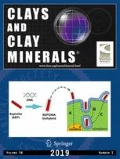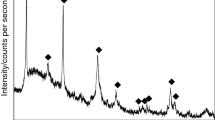Abstract
Hydrothermal reactions in the system sepiolite/H2O have been examined between 149° and 316°C. Approximately 10–20% of the starting sepiolite was converted to a smectite (stevensite) at 204°C within 24 hr. Similar results were obtained when CaCl2, NaOH, Ca(OH)2, or Mg(OH)2 was added to the system. In the presence of NaCl, about 60% of the sepiolite was converted to stevensite, whereas, only 5% stevensite formed in the presence of MgCl2. Greater amounts of stevensite formed at 260°C in these systems. Above 316°C, 60–80% of the sepiolite was converted to stevensite in 24 hr, regardless of the presence or absence of salts. Within the experimental conditions used, temperature is the most important factor in the sepiolite-to-stevensite conversion.
At or below 216°C, sepiolite appears to transform into stevensite by dislocations involving c12 glides that are triggered by the stresses of the hydrothermal conditions. Above this temperature, stevensite seems to form by direct precipitation after dissolution of sepiolite.
Резюме
Изучались гидротермальные реакции в системе сепиолит/Н2O при температуре от 149° до 316°С. При 204°С в течение 24 часов примерно 10–20% начального сепиолита было превращено в смектит (стевенсит). Аналогичные результаты были получены при добавлении СаС12, NaOН, Са(ОН)2, или М§(ОН)2 в систему. В присутствии NaCl около 60% сепиолита было преобразовано в стевенсит, в то время как в присутствии MgСl2 образовалось только 5% стевенсита. Большее количество стевенсита в этих системах было получено при 260°С. При температурах, превышающих 316°С в течение 24 часов 60–80% сепиолита преобразовывалось в стевенсит независимо от присутствия или отсутствия солей. Было установлено, что при соблюдавшихся условиях экспериментов, температура является наиболее важным фактором в преобразовании сепиолита в стевенсит.
При температуре 216°С или ниже сепиолит, повидимому, переходит в стевенсит в результате перемещений, включающих скольжения с/2, которые возникают под влиянием гидротермальных условий. При более высоких температурах стевенсит, повидимому, формируется путем непосредственного осаждения после растворения сепиолита.
Resümee
Hydrothermische Reaktionen im Sepiolit/Wasser System sind zwischen 149° bis 316°C untersucht worden. Ungefähr 10–20% des eingesetzten Sepiolit wurde innerhalb von 24 Stunden bei 204°C zu einem Smektit (Stevensit) umgesetzt. Ähnliche Resultate wurden erhalten, als CaCl2, NaOH, Ca(OH)2, oder Mg(OH)2 zu dem System gegeben wurden. In Gegenwart von NaCl ungefähr 60% des Sepiolit wurde zu Stevensit umgesetzt, wohingegen nur 5% Stevensit in der Gegenwart von MgCl2 geformt wurden. Größere Mengen von Stevensit wurden bei 260°C in diesen Systemen geformt. Über 316°C, 60–80% des Sepiolit wurde innerhalb von 24 Stunden umgesetzt zu Stevensit, ob Salze anwesend waren oder nicht. Im Rahmen der angewendeten Bedingungen ist Temperatur der wichtigste Faktor in der Umwandlung von Sepiolit zu Stevensit.
Bei 216°C und darunter scheint das Sepiolit in Stevensit überzugehen durch Verschiebungen, die c/2 Verrutschungen einbeziehen, welche durch Spannungen von den hydrothermischen Bedingungen ausgelöst werden. Über dieser Temperatur scheint Stevensit durch direktes Ausfallen nach Auflösen von Sepiolit geformt werden.
Résumé
Les réactions hydrothermales dans le système sépiolite/H2O ont été examinées entre 149° et 316°C. Approximativement 10–20% de la sépiolite d’origine a été convertie en une smectite (stevensite) à 204°C en 24 heures. Des résultats semblables ont été obtenus lorsque CaCl2, NaOH, Ca(OH)2, ou Mg(OH)2 étaient ajoutés au système. En présence de NaCl, environ 60% de la sépiolite a été convertie en stevensite, alors que seulement 5% de stevensite était formée en présence de MgCl2. De plus grandes quantités de stevensite ont été formées à 260°C dans ces systèmes. Au dessus de 316°C, 60 à 80% de la sépiolite a été convertie en stevensite en 24 heures, sans égards à l’absence ou à la présence de sels. Sous les conditions expérimentales employées, la température est le facteur le plus important dans la conversion de sépiolite en stevensite.
A 216°C ou en dessous, la sépiolite a l’air de se transformer en stevensite par dislocations impliquant des glissements c/2 qui sont mis en mouvement par les forces des conditions hydrothermales. Au dessus de cette température, la stevensite semble se former par précipitation directe après la dissolution de la sépiolite.
Similar content being viewed by others
References
Brindley, G. W. (1955) Stevensite, a montmorillonite-type mineral showing mixed-layer characteristics: Amer. Mineral. 40, 239–247.
Carney, L. L. and Meyer, R. L. (1976) Anew approach to high temperature drilling fields: Soc. Petrol. Eng., Paper No. SPE 6025, 8 pp.
Faust, G. T. and Murata, K. J. (1953) Stevensite, redefined as a member of the montmorillonite group: Amer. Mineral. 38, 973–987.
Faust, G. T., Hathaway, J. C., and Millot, G. (1959) A re-study of stevensite and allied minerals: Amer. Mineral. 44, 342–370.
Frank-Kamenetsky, V. A., Kotov, N. V., and Klochkova, G. N. (1970) Phase transformations of sepiolite and palygor-skite under hydrothermal conditions at elevated pressure in the presence of KCl and NaCl: Geochem. Int. 7, 934–942.
Frank-Kamenetsky, V. A., Kotov, N. V., and Klochkova, G. N. (1972) Phase and structural changes in sepiolite and pal-ygorskite under hydrothermal conditions in the presence of Ca and Mg chlorides: Geochem. Int. 9, 818–826.
Imai, N., Otsuka, R., Nakamura, T., and Tsunashima, A. (1970) Stevensite from the Akatani mine, Niigata Prefecture, northeastern Japan: Clay Sci. 4, 11–29.
Lee, R. W. and Güven, N. (1975) Chemical interferences in atomic absorption spectrometric analysis of silicates in the fluoboric-boric acids matrix: Chem. Geol. 16, 53–58.
Mumpton, F. A. and Roy, R. (1958) New data on sepiolite and attapulgite: Proc. 5th Nat. Conf. Clays and Clay Minerals, Urbana, Ill., 1956, 136–143.
Otsuka, R., Sakamoto, T., and Hara, Y. (1974) Phase transformations of sepiolite under hydrothermal conditions: Nendo Kagaku 14, 8–19.
Powe, W. H., III (1977) Mineralogical studies on coexisting saponite and sepiolite: M.S. Thesis, Texas Tech University, Lubbock, Texas, 84 pp.
Randall, B. A. O. (1959) Stevensite from the Whin Sill in the region of the North Tyne: Mineral. Mag. 32, 218–225.
Zvyagin, B. B., Mishchenko, K. S., and Shitov, V. A. (1963) Electron diffraction data on the structures of sepiolite and palygorskite: Sov. Phys.—Crystallogr. 8, 148–153.
Author information
Authors and Affiliations
Rights and permissions
About this article
Cite this article
Güven, N., Carney, L.L. The Hydrothermal Transformation of Sepiolite to Stevensite and the Effect of Added Chlorides and Hydroxides. Clays Clay Miner. 27, 253–260 (1979). https://doi.org/10.1346/CCMN.1979.0270403
Received:
Accepted:
Published:
Issue Date:
DOI: https://doi.org/10.1346/CCMN.1979.0270403



